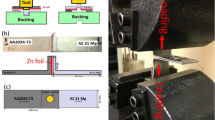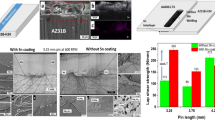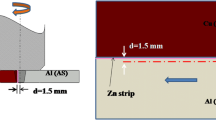Abstract
Improving microstructural and mechanical properties of AA2024 base metal reinforced with AA7075 via vertical compensation friction stir welding (VCFSW) have become a very vital research area to reinforce the weak part of nugget zone in welded joints. So this paper presents a novel and simple method to improve microstructural and mechanical properties especially ductility and fracture locations of welded aluminum joints by VCFSW technique. Anyhow, most of the welded parts are subjected to the forming processes so improvement in the property of ductility and fracture behavior of welded joints is required. One solution to increase ductility and improve fracture behavior of welded joints is the use of interlayer compensation strip width as a reinforcement which has superior mechanical properties between two blanks of base metal during friction stir welding process. The effect of changing interlayer compensation width was investigated on the microstructural characterization (by an optical microscope, scanning electron microscope and transmission electron microscope) and mechanical properties (using microhardness, tensile and bending tests). Microstructure observations revealed that the tailor-welded joint without compensation interlayer contains micro-voids in the stir zone, while in tailor-welded joints with compensation interlayer, the voids completely disappear on the microscale. X-ray diffraction detected that the use of compensation interlayer of AA7075 between two AA2024 blanks led to the appearance of two precipitates of intermetallic phases, Al2Cu and Mg2Zn, on grain boundaries of aluminum which improved ductility and fracture behavior of welded joints. Ductility enhanced till 54.4% at compensation interlayer width 2 mm when compared to the joint without compensation interlayer. Lower hardness values were detected at nugget zone in joint without compensation interlayer. By contrast, highest hardness values in the softened regions were obtained in compensation interlayer joints. Finally, the highest bending angle occurred without any cracks in case of compensation interlayer of 2 mm at ultimate bending load.
















Similar content being viewed by others
References
Z. Kailun, J. Denis, W. Liliang et al., A review on forming techniques for manufacturing lightweight complex-shaped aluminum panel components. Int. J. Lightweight Mater. Manuf. 1, 55–80 (2018)
Y. Morishita, Y. Sakamoto, F. Yoshida, Role of counter punch for square cup drawing of tailored blank composed of thick/thin sheets. J. Mater. Process. Technol. 212(10), 2102–2108 (2012)
R. Mishra, Y. Ma, Friction stir welding and processing. J. Mater. Sci. Eng. R Rep. 50(1–2), 1–78 (2005)
M. Abu-Okail, M.H. Ata, A. Abu-Oqail et al., Production of tailor-welded blanks by vertical compensation friction stir welding technique. J. Mater. Sci. Technol. 34(16), 2030–2041 (2018)
L. Zhang, S. Ji, G. Luan et al., Friction stir welding of Al alloy thin plate by rotational tool without pin. J. Mater. Sci. Technol. 27(7), 647–652 (2011)
R. Nandan, T. DebRoy, H. Bhadeshia, Recent advances in friction-stir welding–process, weldment structure and properties. Prog. Mater. Sci. 53(6), 980–1023 (2008)
J. Guo, H. Chen, C. Sun et al., Friction stir welding of dissimilar materials between AA6061 and AA7075 Al alloys effects of process parameters. Mater. Des. 56, 185–192 (2014)
H. Laieghi, S. Alipour, A. Mostafapour, Heat-assisted friction stir welding of polymeric nano composite materials. Sci. Technol. Weld. Join. (2019). https://doi.org/10.1080/13621718.2019.1610613
A. Mostafapour, G. Naderi, M.R. Nakhaei, Effect of process parameters on fracture toughness of PP/EPDM/ nanoclay nanocomposite fabricated by novel method of heat assisted friction stir processing. Polym. Compos. 39(7), 2336–2346 (2016)
A. Mostafapour, E. Azarsa, A study on the role of processing parameters in joining polyethylene sheets via heat assisted friction stir welding: Investigating microstructure, tensile and flexural properties. Int. J. Phys. Sci. 7(4), 647–654 (2012)
T. Amancio-Filho, S. Sheikhi, J.F. Dos Santos et al., Preliminary study on the microstructure and mechanical properties of dissimilar friction stir welds in aircraft aluminum alloys 2024-T351 and 6056-T4. J. Mater. Process. Technol. 206(1–3), 132–142 (2008)
Z. Zhang, L. Xiao, Y. Ma, Hardness recovery mechanism in the heat-affected zone during long-term natural aging and its influence on the mechanical properties and fracture behavior of friction stir welded 2024Al-T351 joints. Acta Mater. 73, 227–239 (2014)
H. Zhang, Y. Li, Y. Feng et al., Improving mechanical properties of friction stir welded AA2024-T3 joints by using a composite backplate. Mater. Sci. Eng. A 598, 312–318 (2014)
B. Wang, B. He, B. Fan et al., High temperature deformation behavior of friction stir welded 2024-T4 aluminum alloy sheets. J. Mater. Process. Technol. 247, 184–191 (2017)
N. Li, Y. Li, W. Yang, Y. Feng et al., An investigation into the mechanism for enhanced mechanical properties in friction stir welded AA2024-T3 joints coated with cold spraying. Appl. Surf. Sci. 439, 623–631 (2018)
Z. Zhang, W. Li, J. Li et al., Microstructure and anisotropic mechanical behavior of friction stir welded AA2024 alloy sheets. Mater. Charact. 107, 112–118 (2015)
M. Abu-Okail, M.H. Ata, Enhancement ductility of friction stir welded aluminum blanks AA2024 via adding interlayer strip width of AA7075. J. Mater. Res. Express. (2019). https://doi.org/10.1088/2053-1591/ab448c
Y. Ma, H. Feng, L. Chen et al., Recent advances in friction stir welding/processing of aluminum alloys: microstructural evolution and mechanical properties. Crit. Rev. Solid State Mater. Sci. 43(4), 269–333 (2018)
G. Sha, Y.B. Wang, X.Z. Liao et al., Influence of equal-channel angular pressing on precipitation in an Al–Zn–Mg–Cu alloy. Acta Mater. 57, 3123–3132 (2009)
Y. Liu, D. Jiang, B. Li et al., Effect of cooling aging on microstructure and mechanical properties of an Al–Zn–Mg–Cu alloy. Mater. Des. 57, 79–86 (2014)
C.R. Brooks, Translate by Fu Ding. The Heat Treatment, Microstructure and Properties of Non-ferrous Alloy. Chinese Version (Metallurgical Industry Press, Beijing, 1988), p. 111
Acknowledgments
The authors are thankful to Helwan Company for Non-Ferrous Industries for providing the base material and compensation material for this research work and Helwan Engineering Industries Company for converting the milling machine to friction stir welding machine.
Author information
Authors and Affiliations
Corresponding author
Additional information
Publisher's Note
Springer Nature remains neutral with regard to jurisdictional claims in published maps and institutional affiliations.
Rights and permissions
About this article
Cite this article
Abu-Okail, M., Mahmoud, T.S. & Abu-Oqail, A. Improving Microstructural and Mechanical Properties of AA2024 Base Metal by Adding Reinforced Strip Width of AA7075 via Vertical Compensation Friction Stir Welding Technique. J Fail. Anal. and Preven. 20, 184–196 (2020). https://doi.org/10.1007/s11668-020-00814-z
Received:
Revised:
Published:
Issue Date:
DOI: https://doi.org/10.1007/s11668-020-00814-z




